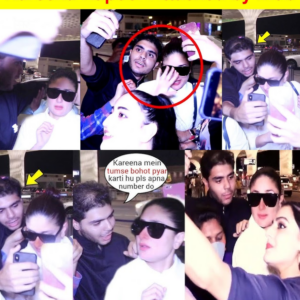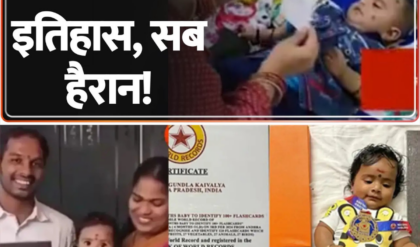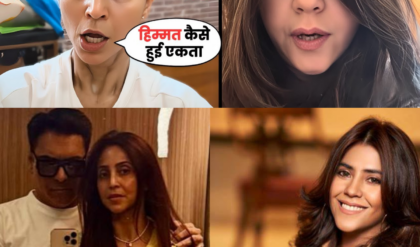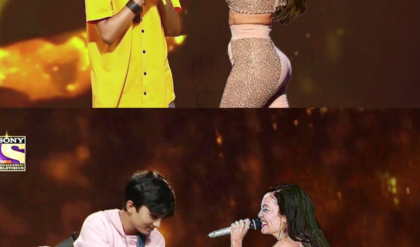Aishwarya Rai’s Daughter Aaradhya Bachchan Dancing Deepfake Video Goes Viral Amid Divorce Rumors: A Discussion on Media Ethics, Technology, and Privacy
The world of Bollywood often finds itself at the intersection of fame, speculation, and privacy, especially when it comes to the Bachchan family. As one of the most renowned families in the Indian film industry, every move of Aishwarya Rai Bachchan, her husband Abhishek Bachchan, and their daughter Aaradhya Bachchan is under constant scrutiny. While their public lives are often captured in the media and celebrated by fans, the intrusion into their personal lives has also triggered debates about privacy, ethics, and the role of technology in shaping the narrative surrounding them.
A recent event has brought these discussions to the forefront: a viral deepfake video featuring Aishwarya Rai Bachchan’s daughter, Aaradhya, dancing. This video, which shows the young girl seemingly performing a dance routine, quickly spread across social media, garnering millions of views. While it initially appeared to be an innocent and entertaining piece of content, it was soon revealed that the video was not authentic. Rather, it was a deepfake, a digitally manipulated creation using advanced artificial intelligence to superimpose someone’s face and actions onto another body.
The timing of this video’s release has raised several questions, particularly because it coincides with ongoing rumors about the marital relationship between Aishwarya Rai and Abhishek Bachchan. In a world where news and social media are often intertwined, it becomes increasingly difficult to distinguish between reality and fiction. This incident not only highlights the risks of deepfake technology but also serves as a stark reminder of the ethical challenges posed by the media’s portrayal of celebrities and their families.
What is a Deepfake and How Does it Work?
Before diving into the impact of the deepfake video, it’s important to understand what a deepfake is and how it works. Deepfakes are hyper-realistic videos or images created using deep learning algorithms, which involve training AI models on large datasets of videos, images, and audio. These algorithms can analyze and replicate specific facial expressions, voice tones, and even mannerisms, enabling the creation of videos that look remarkably real but are entirely fabricated.
While deepfakes are often used for entertainment, such as in movie special effects or parody videos, they have also gained notoriety for their potential to deceive and manipulate. The technology can be used to create misleading content by superimposing a person’s face onto someone else’s body, or by altering audio to make it appear as if someone said something they never did. In the case of Aaradhya Bachchan’s dancing video, the deepfake technology was used to create the illusion that the young girl was performing an elaborate dance, but it was later confirmed that the video was completely fake.
The consequences of such technology are far-reaching, particularly in the context of celebrities and their families. With the proliferation of deepfakes on social media, individuals can be easily manipulated or misrepresented, leading to potential damage to their reputation, privacy, and mental well-being.
The Timing: Divorce Rumors and the Bachchan Family’s Personal Life
Aishwarya Rai Bachchan and Abhishek Bachchan have long been one of Bollywood’s most celebrated couples. Their relationship has been the subject of much media attention, especially since their high-profile wedding in 2007. However, in recent months, rumors of marital discord between the two have been swirling in the media. These rumors have been further fueled by various reports, speculation, and public appearances that have been analyzed and dissected by gossip columns and social media users alike.
Amidst this ongoing speculation about the state of their marriage, the viral deepfake video of Aaradhya emerged. The video, which featured the young girl seemingly dancing, was widely shared, but its release came at a time when the Bachchan family was already in the media spotlight due to the divorce rumors. The intersection of these two events — the viral video and the ongoing rumors about Aishwarya and Abhishek’s marriage — added fuel to the fire, amplifying the controversy.
In a society where the private lives of celebrities are often intertwined with their public personas, any event that attracts attention can quickly become a topic of public discourse. The fact that the deepfake video was linked to the Bachchan family’s ongoing media narrative shows how powerful rumors and digital manipulation can be in shaping public opinion. The public’s fascination with the Bachchans, particularly regarding Aishwarya and Abhishek’s relationship, made it easy for the deepfake video to take on a life of its own.
The Ethics of Deepfake Technology: Privacy vs. Public Consumption
The viral deepfake video of Aaradhya Bachchan raises significant ethical questions about privacy, consent, and the use of technology to create content that can mislead and manipulate. The fact that the video targeted a young child — Aaradhya, who is just 13 years old — is deeply troubling. Children of celebrities, particularly those who are not in the public eye by choice, often bear the brunt of media attention without the ability to control the narrative around their lives. In the case of Aaradhya, her personal moments, family dynamics, and even her appearance have been frequently shared and analyzed by the public, with little regard for her privacy or consent.
Aishwarya Rai Bachchan, as a mother, has often expressed her desire to protect her daughter from the harsh realities of fame. The release of a deepfake video that features Aaradhya dancing without her consent is a direct violation of her privacy. It is important to remember that deepfake technology, while groundbreaking in its capabilities, can be misused in ways that cause significant harm, especially when it comes to minors. In this case, the deepfake video not only misrepresented Aaradhya’s actions but also added to the larger narrative of media speculation about her family’s personal life.
The ethical implications of such content are enormous. Deepfakes have the potential to distort reality, influencing how people perceive celebrities and their families. In this instance, the video of Aaradhya was created to serve as entertainment, but it could also have been used to further fuel false rumors about the Bachchan family. It highlights the need for a greater sense of responsibility in the digital media landscape, particularly when it comes to content involving children and young celebrities.
Moreover, the viral nature of the video raised questions about the role of social media platforms in curbing such content. While these platforms have made strides in removing harmful or misleading content, the sheer volume of deepfake videos being shared makes it difficult for them to keep up. In many cases, deepfakes are not immediately flagged, which allows them to spread rapidly before they can be addressed. The video of Aaradhya Bachchan is just one example of how deepfake content can infiltrate public discourse, causing confusion and distress.
Aishwarya and Aaradhya’s Response: Privacy and Protection
Aishwarya Rai Bachchan, as a mother and a public figure, has always been protective of her daughter’s privacy. In the past, she has made it clear that Aaradhya is not a public figure by choice and that she wishes to shield her from unnecessary media attention. Aishwarya has spoken about her reluctance to expose Aaradhya to the harsh realities of fame, citing her desire to allow her daughter a normal childhood.
In response to the viral deepfake video, it is likely that Aishwarya and Abhishek would have taken measures to protect their daughter’s privacy and ensure that such content does not impact her emotional well-being. While neither Aishwarya nor Abhishek have made a public statement about the specific video, the incident highlights the broader issue of how the media and social media platforms handle the private lives of celebrity children.
It is also crucial to address the emotional toll that such videos can have on families. For a young girl like Aaradhya, seeing her image manipulated and shared online without her consent can be distressing. While Aaradhya may not fully understand the intricacies of digital manipulation, the emotional impact on a child who is constantly under the public’s eye can be profound. Parents like Aishwarya and Abhishek have to navigate the fine line between allowing their child some public exposure while also protecting them from the darker side of fame.
Media Responsibility and Ethical Journalism
In the age of digital media, where content is shared instantaneously and viral videos can dominate the headlines, the responsibility of the media and journalists has never been greater. The viral deepfake video of Aaradhya Bachchan presents an example of how easily information can be manipulated and how such content can be sensationalized by the media.
The media plays a crucial role in shaping public perception, and it is important for journalists and media houses to adhere to ethical standards when it comes to celebrity coverage. In the case of Aaradhya’s deepfake video, many outlets shared the video without verifying its authenticity, further contributing to the spread of misinformation. Media outlets need to prioritize accuracy over sensationalism, especially when it involves children or private individuals who have not chosen to live in the public eye.
Furthermore, the media must take a more active role in promoting digital literacy and educating the public about the potential dangers of deepfake technology. By raising awareness about how deepfakes are created and the harm they can cause, the media can help curb the spread of misleading and harmful content.
Conclusion: The Future of Privacy in the Digital Age
The viral deepfake video of Aaradhya Bachchan highlights a significant issue in the age of digital media: the need to protect privacy and maintain ethical standards in an era of advanced technology. The rise of deepfake technology has introduced new challenges in distinguishing between reality and manipulation, and it is crucial for society, the media, and tech companies to work together to address these issues.
For celebrities like Aishwarya Rai and Abhishek Bachchan, the desire to protect their families from the harmful effects of fame and digital manipulation is understandable.
The viral deepfake video of Aaradhya is just one example of how media and technology can intersect in ways that invade privacy and distort reality. Moving forward, it is important to ensure that the rights of individuals — especially children — are respected in both the digital and real worlds.
Ethical journalism, digital literacy, and privacy protection must be prioritized to ensure that technology is used responsibly and that the personal lives of individuals, particularly minors, are not compromised for the sake of entertainment or sensationalism.
News
Scandalous! Celebrity Caught in a Shocking Incident with a Fan in Public!”
Shocking Incident Involving Kareena Kapoor: A Fan Misbehaves in Front of the Media In a deeply unsettling incident, Bollywood actress Kareena Kapoor Khan found herself at the center of an unexpected and distressing situation when a fan reportedly touched her…
End of content
No more pages to load






